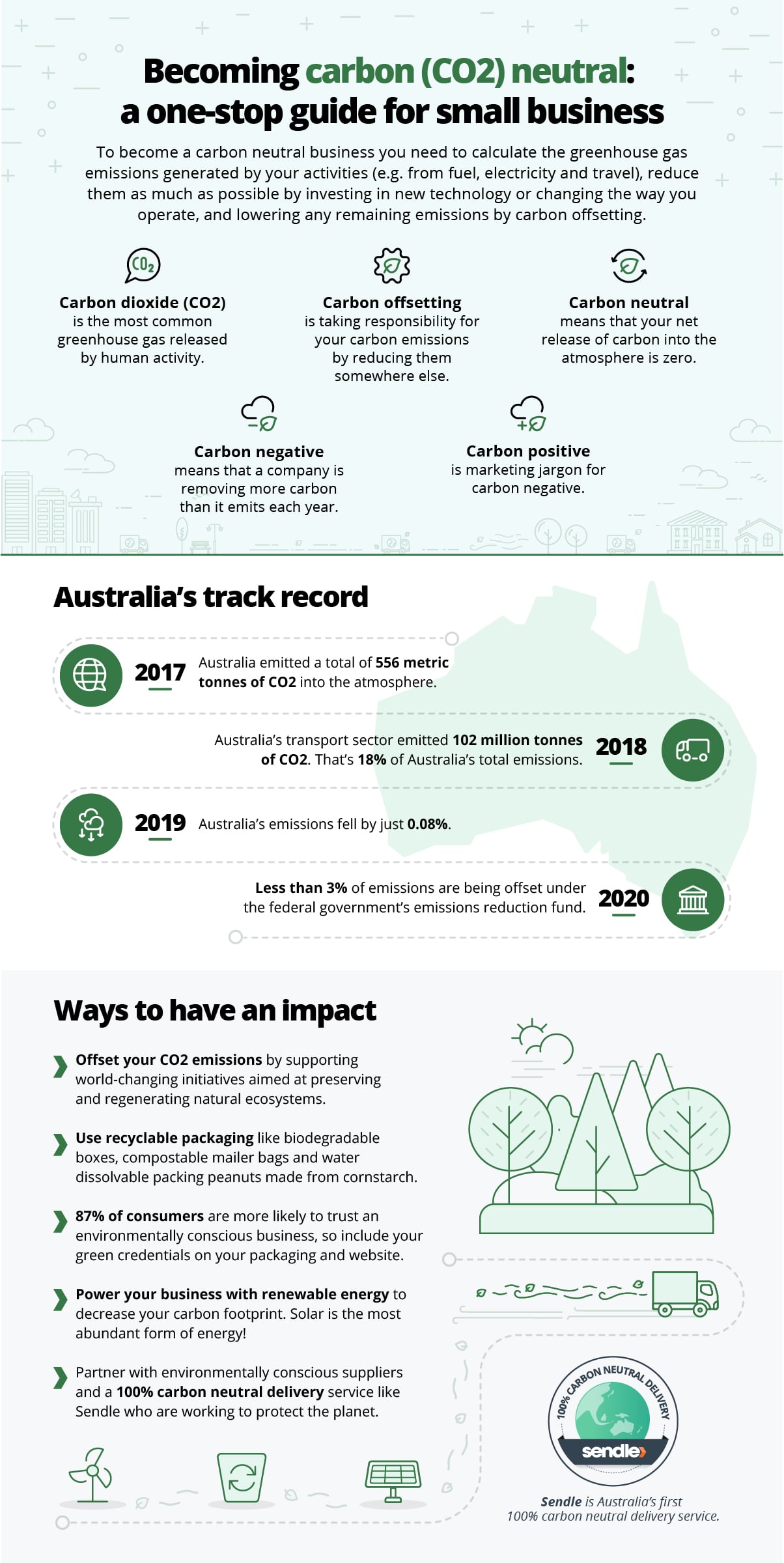How do you reduce your carbon dioxide (C02) emissions? A growing number of small businesses are looking for ways to reduce their environmental impact, but it can be challenging to know where to start.
Sendle is the first 100% carbon neutral delivery service in Australia and the United States, and we maintain that commitment to this day. We’re also Australia’s first tech B Corp! And we want more businesses to join in our advocacy for the planet.
Small community businesses like local coffee shops can reduce waste by using mugs instead of paper cups and offering oat milk as a substitute for cow’s milk.
Why should businesses strive to be carbon neutral?
Nowadays, we hear talks of sustainability a lot regardless of the industry. Luxury retail brands are starting to upcycle to end fast fashion, the famous Tesla is the first of its kind to be an automotive and clean energy company, and Sendle is changing the shipping industry by being the first 100% carbon neutral logistics service and have committed to be Net Zero by 2030. These sustainable efforts may seem completely different from one another, but the goal is ultimately the same: to reduce the company’s impact on the planet.
Businesses, especially large corporations, naturally produce the highest waste in any one place. That’s because a lot of resources are needed to produce anything, whether it be food, toys, or furniture. Factories take up a huge space, plantations require thousands of gallons of water per month, and a lot of packaging requires a lot of plastic. All this waste contributes to a company’s carbon footprint and overall impact on the planet–and a negative one at that.
Nowadays, corporate social responsibility is a crucial part of brand image and reputation. Furthermore, it’s one of the most powerful aspects of customer loyalty. Consumers don’t just care about how companies treat them as customers but also look at how the company culture treats its employees, if the company engages with the community, or if it honors dedicated employees with service awards.
For many industries with little space for product differentiation, brand image could be the deciding factor for consumers. And if you spread the word about your environmental efforts, you’ll surely attract a new audience!
The 2022 Think Before You Ship campaign places the focus on small businesses and how they can improve their business practices and lessen their environmental impact. Check out our Sendle with Care whitepaper to learn more!
Carbon neutral and other sustainability terms
The saying, “going green” comes with a new kind of language or jargon (terms like carbon neutral, net zero, carbon offsets, and carbon positive).
If you don’t have previous experience with carbon neutral efforts or aren’t environmentally aware yet, it can be difficult to pinpoint what these terms mean or understand the differences between them.
Understanding the lingo is an important first step for any small-business owner who wants to roll out strategies for going carbon neutral or at least lowering carbon emissions, so we’ve broken down the basics.
What is a carbon neutral businesses?
A business that is carbon neutral balances its total release of carbon emissions with carbon offsets, making its net release of carbon dioxide into the atmosphere zero. This means that the company retains its operations, calculates its carbon emission, and implements projects that account for that carbon by conserving and replanting forests and other vital ecosystems, therefore offsetting its original carbon emission.
What is carbon offsetting for businesses?
A business that is carbon offsetting takes responsibility for its carbon emissions by absorbing them somewhere else. A popular example of carbon offsetting is when a business plants a tree for every item sold.
There are many ways to offset and be carbon neutral: regenerating precious forests, replacing old equipment with more efficient technology, or even training communities in beekeeping! Sendle, for example, partners with South Pole to fund wildlife conservations and reforestations around the world. Learn more about how we offset our carbon emissions on our impact page.
What is a carbon negative business?
A business that is carbon negative absorbes more carbon dioxide from the atmosphere than it emits each year. A loose example would be planting two trees for every product sold rather than one. You may also hear the term ‘carbon positive’ used to describe this approach.
While all businesses should strive to become carbon neutral, an even better goal is to become carbon negative. This way, a business not only offsets its own carbon emissions, but also that of others. Given the current state of the planet and its climate, being carbon neutral does not offset all the damage that’s been done in the past.
For many large and influential corporations like Microsoft and Ikea, becoming carbon negative is a priority. They’ve pledged to achieve carbon negativity by 2030.

Is going carbon neutral profitable?
We’ve seen countless small businesses go green and thrive. As mentioned earlier, multi-billion companies are focusing on going carbon neutral or even carbon negative, because that is how they'll continue to dominate in their respective markets.
According to research by non-profit organization CDP, companies who plan and implement changes to manage climate change gain an 18% higher return on investment than businesses that don’t. Additionally, companies have seen their sales for sustainable products grow 5.6 times faster than their non-sustainable alternatives.
Furthermore, it’s a common misconception that sustainable practice leads to more expensive operations. For example, powering your business with renewable energy (e.g. wind or solar) not only decreases your carbon footprint, but also slashes your monthly power bill. Long term investments towards sustainability such as this will save businesses way more money than short-term band aid solutions that either have to be renewed constantly or increase risks that end up more costly.
In reality, all it takes to become a carbon neutral business is a bit of careful planning, a supportive small-business community by your side, and being equipped with the right information.
Looking to reduce your business’ carbon footprint without additional costs? Enjoy the lowest shipping rates in Australia and the United States with Sendle–your 100% carbon neutral partner in logistics. Reduce your carbon emissions instantly by choosing the greener alternative.
We hope this guide will help you, as you set out on the carbon neutral journey and do your bit for the planet we call home. Remember that whether you’re a large business or an individual who happened to come by this guide, your impact matters. Don’t hesitate to spread the word and share this blog with your friends!


